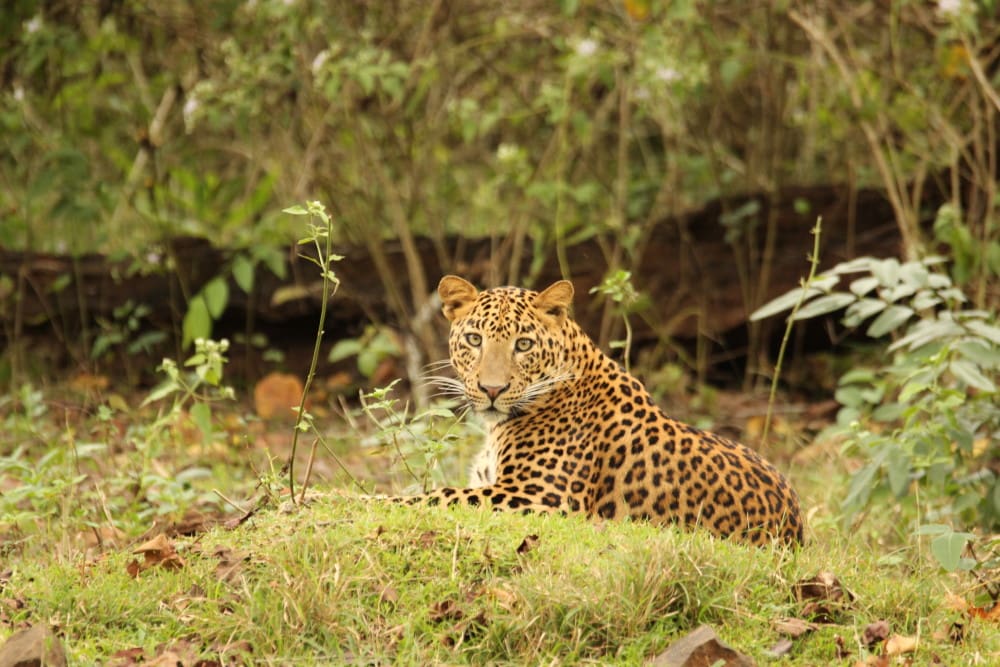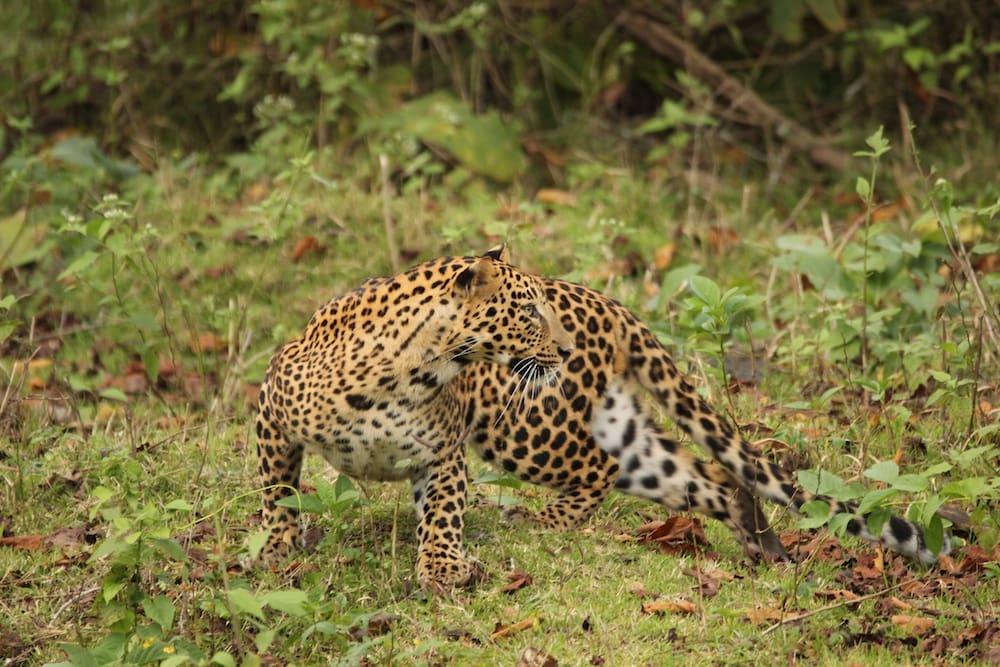Wisdom and musings from a 50-minute encounter with a leopard in Nagarahole
Six days short of four years and twelve safaris is what it took for my first big cat sighting. The wait was agonizing and ended in an experience liberating. A subadult male leopard (Panthera pardus fusca), broke the jinx by offering us a sighting which was an abridged version of leopard behavior.
At half past four midweek in early december we were on a safari in of the Nagarhole National Park. A Forest Department jeep was ahead of us and as we started to fork away onto a different track, we could see the staff in the Forest Department jeep waving at us. Our naturalist picked up the binoculars and declared there was a leopard on the ground. Our jeep moved in the direction of the said sighting and within half a minute we could see the leopard on the ground sitting on a mound beside a tree. The leopard was to the right of the safari jeep.

Big Cat – Check. But this cat was determined not be a check mark, but a deep impression that would bring up the vision of that early December evening every time the word leopard was mentioned.



At less than 60 meters (I am being conservative, some could argue it was much closer) the leopard was just fitting into the frame at a zoom of 400 mm X 1.6. The hushed tones in the safari jeep did little to hide the excitement. A series of fervent clicks started from the fear of not making the most of the opportunity.

The cat on the other side was unperturbed by the presence of two jeeps with a dozen humans. The Forest Department jeep moved on after, I believe, five minutes and there arrived another safari jeep with more about ten visitors, followed later by a Forest Department safari van with an equal number of occupants. We expected the leopard to move due the three score eyes prying upon it. The leopard yawned twice and and stretched itself between five to seven minutes – an action that could be creatively interpreted as its indifference to prying eyes. It licked its paws and we were told that big cats display such a behavior that follows after a meal. I wondered if the leopard’s indifference was akin to the relaxed attitude displayed by some humans at work after a Friday lunch. A ten-minute sighting was more than I could ask for and when the leopard started to move toward the Lantana bushes at around ten minutes, I presumed it was done with us.


My presumption was put down by a firm swat from the leopard’s tail as it made itself comfortable by a bush, in what I consider a classic leopard pose – crouched close to the ground. It then sat in a cat-like pose, resting on its hind legs with front legs upright.

At twelve minutes into the sighting the leopard got restless, it stood up on its hind legs holding something in its paws. In a few seconds it emerged it was holding a rock somewhat larger than a cricket ball in its front paws while taking a few steps on its hinds. Observing this perplexing behavior I wondered how the leopard could do that, which is when I realized, why not after all the leopard is a tree climber. The leopard then dropped the rock and stood on its hind legs again, resting its forepaws on a fallen log of wood about four feet high. It gnawed at the wood, and then walked toward the Lantana.


A quarter of an hour had passed since our sighting began and I presumed the leopard was going into the bushes, for with my track record of safari sightings a fifteen-minute sighting was like Quentin Tarantino giving himself a cameo of more than 30 minutes in his films. But the leopard turned around right before the lantana bushes, and then sat down.


Something caught the attention of the leopard in the seventeenth minute, for it looked it the direction our jeep was facing. But it settled down and started walking again in around the twenty-second minute. From the time the safari had begun the mood in the safari jeep had changed from pessimism, to disbelief, to realistic expectations, to optimism bordering on fantasy – in hushed tones, there was hope of seeing the leopard climb a tree.

The leopard yawned and changed positions, walked behind the bushes, looking around from behind a log, walked back towards our left as we faced the leopard, scanned the surroundings from behind a tree. It then emerged and sat in the open, scanned the surroundings, got startled, and crouched behind a bush at minute forty.


Around minute fifty the naturalist accompanying us gave us an option of moving on. I glanced at all the faces hoping someone would object and demand that we stay put but no one did. We left reluctantly bidding farewell to our majestic friend, albeit temporarily. We passed across the other safari jeep that was facing us and moved beyond.
Fifty to hundred meters ahead, we spotted a Sambar stag (Cervus unicolor) on the left side of the jeep track (note: the leopard was on the right side of the jeep track in the bearing we were headed) walking towards the direction that would place is across the jeep track from where the leopard was. We were hoping for an alarm call. None came. A minute passed and the Sambar moved, oblivious to the presence of a predator on the other side. Nor did the predator (which we presumed had just completed a meal) seem to notice.

Our naturalist suggested we wait and watch. Everyone in the jeep gladly agreed. The Sambar kept moving and emerged in the view of the leopard and at this moment the leopard stood up, crossed the jeep track in front of the safari jeep, and started a slow pursuit of the Sambar. The leopard exhibited an intermittent walk-crouch approach and went down a pit and hid behind the bushes. The jeeps moved closer and stopped. The leopard was climbing over the pit when the Sambar gave an alarm call, turned around, and started stomping its front right hoof. The spotted deers (Axis axis) at a distance echoed the Sambar’s fear. The leopard would have faced the Sambar for a second and then moved into the lantana on the other side. The Sambar continued the action and we waited for the leopard to emerge from behind the lantana. More than five minutes passed and the Sambar let down its guard and moved to the other side and started preaching (see notes) against a tree. After about sixty five minutes of drama, we moved on with emotions akin to coming out from a Ridley Scott film. Once outside the safari gate we analyzed if the presence of two safari jeeps could have alerted the Sambar – only the Sambar can tell how it got a whiff of the leopard’s presence.



The experience ended four years of wait but it has underscored the point that it would take many more safaris to get even a novice’s view of big cat behavior.
Notes:
On getting home I sifted through J C Daniels’s The Leopard In India, the geographical undulations in the pursuit we saw were in my view similar to Raza Tehsin’s experience he has described on Page #87 – for it involved intermittent movement of the leopard between flat land and depressions. The closest the leopard got to the Sambar must have been about 30 meters.
Daniel also presents descriptions of the leopard’s senses — a leopard does not have a keen sense of smell; however it has a keen sense of sight and hearing. He goes on to add that a leopard’s keen sight ignores motionless objects. Our jeeps did move and we did within the jeeps, so the leopard would have been aware of our presence.
In the same book, Brooke Fox notes that when a panther’s pursuit is disturbed by a human, it gives a few grunts and makes off.
The Sambar I noticed had a bloody patch on its neck, I had initially presumed the Sambar had been attacked by a carnivore, but learnt from Aditya Gangadharan’s blog that it is a result of a Sambar stag’s display of dominance called “preaching”. Note, once the leopard went away, the Sambar moved toward a flock of spotted deer and displayed this behavior of standing up against a tree and rubbing its neck on the tree.
Also on The Green Ogre:
Arun Menon’s encounter with a Leopard at Mudumalai National Park after which I took my first safari in a Tiger Reserve.
Sandy’s piece on the capture of a Leopard at the Infosys campus in Mysuru
Beej’s note on Kalyan Varma’s photo essay on the capture of a Leopard at Valparai
Photos and Text: Anand Yegnaswami
- Kutch Diaries – Spying on the elusive Desert Cat - June 10, 2020
- Kutch Diaries: Up close with the raptors of Banni - May 24, 2020
- Kutch Diaries – Going Waku Waku with Sandgrouse in Banni - April 29, 2020



One thought on “Prying on a leopard – Panthera pardon us!”